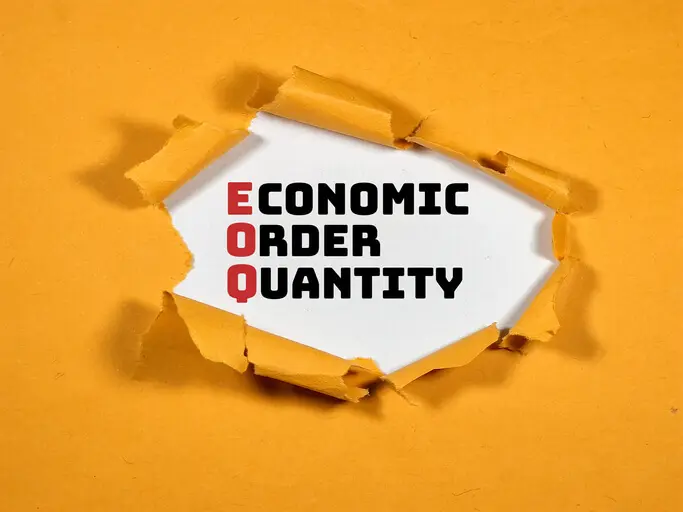Efficient inventory management serves as a cornerstone for the success of businesses, irrespective of their size or industry. It ensures the seamless flow of goods, prevents stockouts, minimizes holding costs, and maximizes customer satisfaction. Proper inventory planning allows businesses to maintain optimal stock levels, avoid excess inventory, and meet customer demands promptly, leading to improved profitability and a competitive edge in the market. In this article we will explain EOQ.
What is EOQ (Economic Order Quantity)?
What is economic order quantity and what’s the EOQ definition? Economic Order Quantity (EOQ) is a fundamental inventory management technique that helps businesses determine the optimal order quantity that minimizes total inventory costs and is essential in supply chain management. EOQ takes into account both the costs of holding inventory, such as warehousing and storage expenses, and the costs of ordering, such as shipping and handling costs. By finding the ideal balance between these costs, businesses can avoid the pitfalls of overstocking or understocking, thus optimizing their inventory management strategy and ensuring the smooth flow of operations.
How Does EOQ Work?
The process of calculating EOQ, as stated above in the economic order quantity definition, involves finding the point where the costs of holding inventory and the costs of ordering inventory are at their minimum. Key factors influencing EOQ calculation include demand rate, ordering costs, and holding costs. Real-life scenarios illustrate the significance of EOQ in ensuring efficient inventory management, as businesses can use the calculated EOQ to make informed decisions about inventory replenishment, order quantities, and stock control strategies.
Let’s consider a real-life scenario involving a manufacturing company that produces electronic components. The company experiences fluctuating demand for its products due to varying consumer preferences and market trends. The company aims to optimize its inventory management by implementing the economic order quantity model to balance the costs of holding inventory and ordering inventory.
Calculation of Economic Order Quantity (EOQ)
Accurate EOQ Calculation is crucial for businesses to strike the right balance between inventory holding costs and ordering costs. Key steps in the EOQ calculation process include:
1. Gathering Necessary Data: Collecting data on demand rates, ordering costs, and holding costs.
2. Applying the EOQ Formula: Utilizing the EOQ formula – EOQ = √((2 * Demand * Ordering Cost) / Holding Cost) – to calculate the optimal order quantity.
3. Interpreting the Results: Analyzing the results to determine the most cost-effective order quantity for the business.
Remember the example above?
In this scenario, the company gathers the following data for one of its high-demand electronic components over a specific period:
Annual demand for the electronic component: 10,000 units
Cost of placing an order: $50 per order
Holding cost per unit per year: $5
The company calculates the economic ordering quantity using the EOQ formula:
EOQ = √((2∗Demand∗Ordering Cost)/Holding Cost)
The company calculates the Economic Order Quantity for the electronic component, using the formula for EOQ, as follows:
EOQ = √((2 * 10,000 * $50) / $5) = √((1,000,000) / $5) = √200,000 = 447 units
By implementing the EOQ model using the formula of EOQ, the company determines that the optimal order quantity for the electronic component is 447 units. With this information, the company can now adjust its ordering policies and inventory levels to ensure that it orders the component in batches of 447 units, reducing the overall costs associated with inventory holding and ordering.
Furthermore, the company can use the EOQ model to plan its production schedules, minimize storage costs, and avoid stockouts or overstocking issues. By regularly recalculating the EOQ based on changing demand patterns and market dynamics, the company can ensure that its inventory management remains efficient and cost-effective, leading to improved profitability and customer satisfaction.
Considerations and enhancements in the EOQ calculation process involve incorporating additional factors such as lead time variability, stock-out costs, and price discounts to refine inventory management strategies further.
Variants of EOQ
Let’s delve deeper into the basic and advanced models of Economic Order Quantity (EOQ), as there are many economic order quantity models, to gain a comprehensive understanding of their functionalities and applications in inventory management.
Basic EOQ Model: The Basic EOQ Model serves as the foundational framework for inventory management and is primarily used to determine the optimal order quantity that minimizes the total costs associated with inventory management. It operates under several key assumptions, including constant demand, fixed ordering and holding costs, and the absence of quantity discounts. The EOQ equation for the Basic EOQ Model is:
EOQ = √((2 * Demand * Ordering Cost) / Holding Cost)
While the Basic EOQ Model provides a simple and effective approach to inventory optimization, it may not account for real-world complexities, such as variable demand patterns, price discounts for bulk ordering, or fluctuating ordering and holding costs.
Advanced EOQ Models: Advanced EOQ Models are extensions of the Basic EOQ Model that incorporate additional complexities and factors to provide more accurate and nuanced solutions for complex inventory management scenarios. These models aim to refine the EOQ calculation process by considering various practical variables and constraints that may impact inventory management decisions. Some of the common types of advanced EOQ models include:
1. Quantity Discount Models: These models account for discounts offered by suppliers for ordering in large quantities. They help businesses determine the most cost-effective order quantity that maximizes the benefits of quantity discounts while minimizing total inventory costs.
2. Production Run Models: These models are applicable in scenarios where products are manufactured in batches or production runs. They aim to optimize the production schedule and order quantities to minimize production costs and ensure efficient inventory management.
3. Reorder Point Models: Reorder Point Models work in conjunction with the EOQ model and help businesses determine the optimal time to place a new order based on the lead time, safety stock, and demand variability. These models ensure that businesses maintain adequate stock levels to meet customer demand while avoiding stockouts and disruptions in the supply chain.
4. Stochastic Demand Models: These models are designed to handle scenarios where demand patterns are uncertain or follow a stochastic process. They incorporate probabilistic methods to predict demand variability and assist businesses in making informed decisions regarding inventory levels and order quantities to minimize the inventory risks associated with demand uncertainty.
By leveraging these advanced EOQ models, businesses can enhance their inventory management strategies, optimize supply chain operations, and make data-driven decisions that align with the dynamic nature of the market and evolving consumer demands. It is essential business determine how to best model EOQ.
Benefits of Using EOQ
The implementation of economic order quantities offers several key benefits, including:
1. Cost Reduction in Holding Inventory: By determining the optimal order quantity that minimizes holding costs, businesses can effectively reduce the expenses associated with storing and managing excess inventory. Maintaining an optimal inventory level ensures that businesses do not tie up valuable resources in unnecessary stock, leading to significant cost savings over time. Moreover, by preventing overstocking, businesses can avoid potential losses due to product obsolescence or damage, further reducing holding costs.
2. Minimizing Order Quantity and Order Costs: EOQ helps businesses minimize the number of orders placed, thus reducing the associated order costs such as administrative expenses, shipping fees, and handling charges. By consolidating orders into larger quantities based on the calculated EOQ, businesses can take advantage of economies of scale and negotiate better pricing with suppliers, leading to additional cost savings by making an economic quantity order. Minimizing order quantity and order costs contributes to improved financial performance and enhanced competitiveness in the market.
3. Maximizing Operational Efficiency:
By maintaining an optimal balance between inventory holding costs and order costs, businesses can ensure a streamlined and efficient supply chain operation. With the right quantity of inventory on hand, businesses can meet customer demands promptly, reduce lead times, and avoid potential stockouts. Maximizing operational efficiency through the implementation of the EOQ model enables businesses to enhance customer satisfaction, build stronger relationships with suppliers, and gain a competitive advantage in the industry.

Overall, the benefits of using the EOQ model extend beyond mere cost savings. They encompass the optimization of inventory management processes, the enhancement of overall operational efficiency, and the facilitation of strategic decision-making, thereby positioning businesses for sustainable growth and success in the dynamic business landscape.
Limits and Considerations in EOQ Usage
While the Economic Order Quantity (EOQ) model is a valuable tool for optimizing inventory management, it is essential to recognize its limitations and consider practical considerations to ensure its successful implementation within a business. Some key limitations of applying EOQ include:
1. Assumption of Stable Demand: The EOQ model operates under the assumption of a constant demand rate, which may not accurately reflect real-world scenarios where demand patterns are subject to fluctuations and variations. Sudden changes in consumer preferences, market trends, or external factors can significantly impact the accuracy of the EOQ calculation, leading to potential inventory imbalances.
2. Static Costs Assumptions: EOQ assumes fixed ordering and holding costs, disregarding potential changes in these costs over time. In practice, businesses may experience fluctuations in these costs due to factors such as inflation, changes in supplier pricing, or shifts in market conditions. Failing to account for dynamic cost variations can result in inaccurate EOQ calculations and suboptimal inventory management decisions.
3. Limited Application to Complex Scenarios: The basic EOQ model may not be suitable for addressing complex inventory management scenarios that involve multiple products, variable demand patterns, or diverse supply chain structures. In such cases, businesses may need to resort to advanced inventory management techniques or software solutions that can accommodate the complexities of their specific operational requirements.
To successfully implement the EOQ model, businesses should consider the following practical considerations:
1. Regular Monitoring and Adjustments: Businesses should regularly monitor inventory levels and reassess the EOQ calculation to account for changes in market dynamics, demand patterns, and cost fluctuations. By adopting a proactive approach to monitoring, businesses can make timely adjustments to their inventory management strategies and ensure optimal stock levels.
2. Integration of Advanced Inventory Management Systems: Implementing advanced inventory management systems that can automate the EOQ calculation process and provide real-time data insights can significantly enhance the accuracy and efficiency of inventory control. These systems can help businesses streamline their supply chain operations, improve decision-making processes, and maintain a competitive edge in the market.
3. Cross-Functional Collaboration: Encouraging collaboration between different departments, including procurement, logistics, and sales, is crucial for the successful implementation of the EOQ model. Cross-functional teams can work together to share insights, align objectives, and develop comprehensive inventory management strategies that cater to the holistic needs of the business.
By acknowledging the limitations of the EOQ model and adopting practical considerations for its implementation, businesses can leverage the benefits of the EOQ model effectively, optimize their inventory management practices, and ensure sustainable growth and success in the competitive business landscape.
How to Implement EOQ in Your Business
Implementing EOQ within a supply chain requires practical steps, including:
1. Assessing Current Inventory Management Practices: Evaluate existing inventory management processes to identify areas for improvement.
2. Investing in Inventory Management Software: Utilize advanced inventory management software to automate the EOQ calculation process and streamline inventory control.
3. Employee Training and Education: Provide training to employees involved in inventory management to ensure a comprehensive understanding of the EOQ model and its application.
Encouraging readers to consider the implementation of EOQ in their own operations can lead to greater efficiency and profitability, enabling businesses to maintain a competitive edge in the market and ensure sustainable growth and success.
Download our free guide on how to introduce demand planning solutions into your business.






